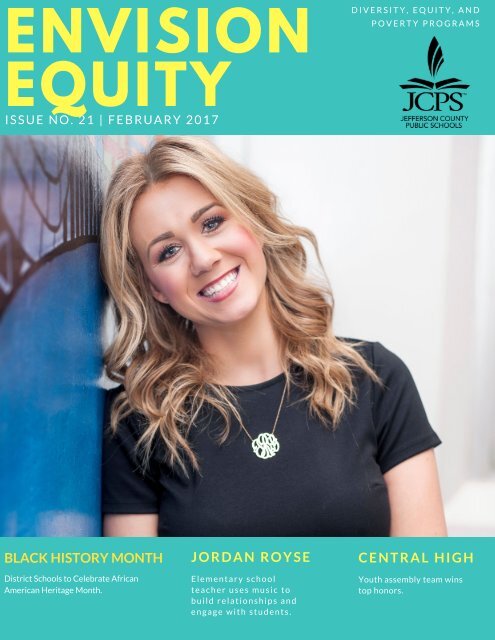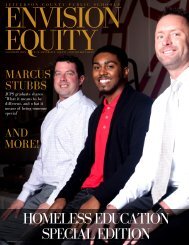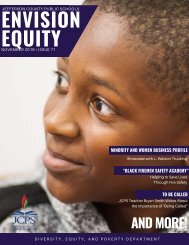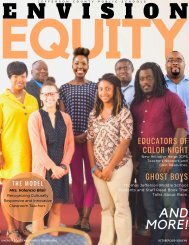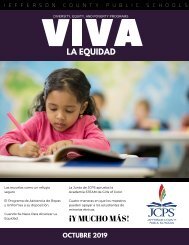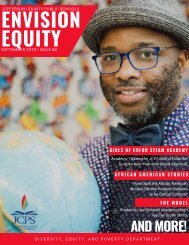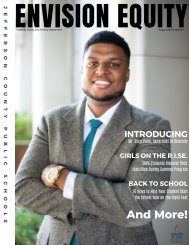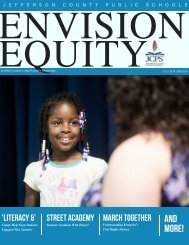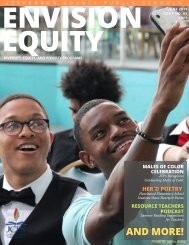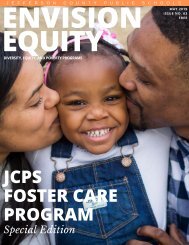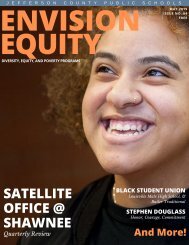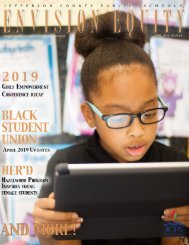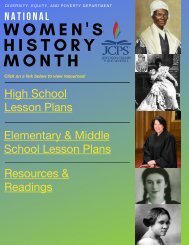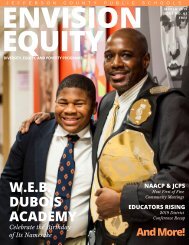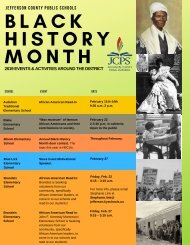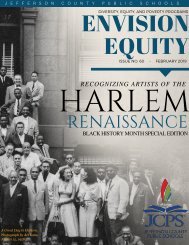Envision Equity: February 2017 Edition
Readers, We hope you enjoy the 21st edition of our Envision Equity newsletter highlighting the work of the community and faith-based organizations in our city. Remember that Envision Equity is also your newsletter. We hope that you will submit articles that celebrate and demonstrate diversity and inclusion. As a reader, you will have access to photos from events that embody the purpose of this newsletter. Please feel free to peruse our Flickr account, which is posted under the cover page. We hope you enjoy, share, and contribute to the newsletter. Lastly, remember to envision equity.
Readers,
We hope you enjoy the 21st edition of our Envision Equity newsletter highlighting the work of the community and faith-based organizations in our city. Remember that Envision Equity is also your newsletter. We hope that you will submit articles that celebrate and demonstrate diversity and inclusion. As a reader, you will have access to photos from events that embody the purpose of this newsletter. Please feel free to peruse our Flickr account, which is posted under the cover page.
We hope you enjoy, share, and contribute to the newsletter. Lastly, remember to envision equity.
Create successful ePaper yourself
Turn your PDF publications into a flip-book with our unique Google optimized e-Paper software.
1<br />
Photo, Getty Images
Above, JCPS teacher Jordan Royse works with<br />
her students during morning class.<br />
Jordan Royse<br />
High Expectations, Engagement, Relationships,<br />
Planning and Resources Fuel Student Learning.<br />
By Jordan Royse—Teacher, Klondike Lane Elementary<br />
Photos, Abdul Sharif<br />
I’ve learned so much in my three short<br />
years of teaching. For the first two years,<br />
my fifth grade team departmentalized, and<br />
I was the math teacher. I strengthened my<br />
instruction in math and focused on creating<br />
mathematicians. This year, departmentalization<br />
vanished, and I am learning the ropes as a<br />
comprehensive fifth grade teacher. With this<br />
switch, a shift in my learning occurred. I am again<br />
a new teacher and work hard to stay one-step in<br />
front of my students. As a classroom of learners,<br />
engagement is my top priority.<br />
High Expectations<br />
On the first day of school, I say to my students,<br />
“You were chosen to be in the best classroom<br />
because you are the best students in the school,<br />
and together, we are going to be the best class.” I<br />
am a very competitive person and expect<br />
2<br />
Continue on next page
excellence. I emphasize this expectation daily.<br />
Everything is a healthy competition and as a<br />
class, we must win-from our behavior to our<br />
academics. We will settle for nothing less! My<br />
goal is to convince my students to believe and<br />
honor this. I work hard to instill in them a<br />
sense of pride. We write a class pledge and<br />
recite it<br />
every day.<br />
Rita<br />
Pierson, an<br />
educator<br />
and<br />
mentor,<br />
says, “You<br />
say it long<br />
enough, it<br />
starts to be<br />
a part of<br />
you.” Her<br />
words of<br />
wisdom<br />
from the<br />
Ted Talk: “Every Kid Needs a Champion,” ring<br />
true each day in my classroom. Holding my<br />
students to the highest expectations forms<br />
the foundation for my classroom success.<br />
Relationships<br />
Above, students in Ms. Royse’s class participate in<br />
a morning activity.<br />
Relationships matter. This is nothing new and<br />
every teacher will share this as best practice. I<br />
choose to make this happen each day. I spend<br />
the first part of my year developing strong<br />
relationships with my students through<br />
eating lunch with them every day. This may<br />
happen as a whole group, small group, or<br />
individually. I forgo eating with my colleagues<br />
or taking those twenty minutes for myself in<br />
order to develop relationships that our<br />
scheduled and rigorous instructional time<br />
does not allow. I make a conscious effort to<br />
attend student activities outside school, such<br />
as community football games and pageants,<br />
and share evening dinners at their homes in<br />
order to<br />
develop deep<br />
relationships.<br />
I am very<br />
vulnerable to<br />
my students,<br />
but I<br />
contribute a<br />
large part of<br />
my success in<br />
the classroom<br />
to this<br />
intimacy.<br />
Because of<br />
these<br />
relationships,<br />
within a few months, my classroom<br />
management requires very little effort. My<br />
students and their families know I care<br />
through my actions. This open relationship<br />
and communication strengthens my<br />
classroom academically, behaviorally,<br />
socially, and emotionally.<br />
Engagement<br />
Student engagement begins the first day my<br />
students enter the classroom. Student<br />
engagement stems from interest in the<br />
curriculum. Teaching must be lively! My two<br />
points of reference are to think social and fun.<br />
Continue on next page<br />
3
Engagement is not only for the students. As<br />
the unengaged teacher, I cannot transfer the<br />
learning to my students.<br />
The emphasis in my classroom is on the<br />
students’ constructing knowledge, not on me<br />
delivering content. I approach their daily<br />
learning as if<br />
everything<br />
they learn is<br />
the most<br />
important<br />
and the most<br />
exciting<br />
piece of<br />
information.<br />
My<br />
enthusiasm<br />
(even if a bit<br />
exaggerated)<br />
translates to my students, creating an<br />
engaging environment.<br />
Above, students in Ms. Royse’s sing<br />
to learn during a morning activity.<br />
Planning<br />
As I plan, my number one concern is<br />
connecting skills and concepts to student<br />
interests. There must be authentic purpose if I<br />
want to capture my students’ attention. My<br />
classroom is very diverse, but each student<br />
shares similar interests and passions. Beyond<br />
the school walls, my students (and me!) are<br />
infatuated with technology, games, social<br />
media, entertainment, and friends. Any<br />
chance I have, I attempt to incorporate these<br />
into their learning.<br />
My students love when I incorporate music<br />
into the curriculum. To help us remember the<br />
steps for long division, we act out and sing a<br />
“I make a conscious effort to<br />
attend student activities<br />
outside school, such as<br />
community football games<br />
and pageants, and share<br />
evening dinners at their homes<br />
in order to develop deep<br />
relationships. “<br />
parody of<br />
“Gangnam<br />
Style” called<br />
“Long Division<br />
Style”. The<br />
students can<br />
easily<br />
remember the<br />
song and then<br />
apply that to<br />
completing long<br />
division with multidigit<br />
numbers.<br />
Another music<br />
opportunity to<br />
incorporate music<br />
was our dance to<br />
Cupid Shuffle. We<br />
use hand<br />
movements to<br />
help remember the<br />
order of<br />
operations.<br />
Recently, we have been rapping to “Text<br />
Structure Baby”, a rap to help us identify text<br />
structures on non-fiction texts.<br />
If there is a<br />
popular<br />
new dance<br />
that my<br />
students<br />
will not<br />
stop doing<br />
in our<br />
classroom, I change the words and lyrics to<br />
help them remember content. It allows me to<br />
connect with students on their level and get<br />
4
my<br />
message<br />
across,<br />
even<br />
though<br />
they may<br />
laugh at<br />
Above, Ms. Royse engages students.<br />
me.<br />
Rapping may be at my expense but my students<br />
come to school asking, “Are you going to rap<br />
about text<br />
structures<br />
again today?”<br />
Students are<br />
excited to learn<br />
and the<br />
content sticks<br />
with them.<br />
When possible,<br />
I deliberately<br />
construct<br />
learning<br />
Above, students in Ms. Royse’s class participate in an<br />
interactive group activity.<br />
activities into games. The aspect of<br />
competition is the driving force of motivation in<br />
my classroom, especially for young men of<br />
color. Competition in curriculum-based<br />
activities becomes a source for excelling and<br />
developing a sense of pride in my young men.<br />
The sense of competition allows students to<br />
take ownership and push others toward<br />
success.<br />
My students are tactile learners and learn from<br />
experience. In math, we use the traditional base<br />
ten blocks and fraction strips, but as the<br />
operations get more complex, I need to think<br />
outside the box. I let them use play-doh to<br />
represent multiplying a fraction by a fraction.<br />
Candies, cakes, and brownies make for great<br />
models as a concrete strategy to<br />
conceptualizing operations with fractions.<br />
We complete scoots and scavenger hunts to get<br />
them up, and moving around the room. My<br />
students are eager to move, so I imbed such<br />
movement to guide instruction. Each day we<br />
clap and act out vocabulary words. My class is<br />
in constant motion. Students are standing on<br />
their desks, chairs, or moving around the room.<br />
They exert their energy<br />
through strategic learning<br />
activities.<br />
Resources<br />
I am constantly reading<br />
education blogs and<br />
searching websites for<br />
ideas. Through my<br />
student relationships, I<br />
know their interests and<br />
actively search for<br />
creative ways to incorporate these in our<br />
learning. Here are a few of my favorite<br />
resources:<br />
Blogs:<br />
• Teaching With a Mountain View:<br />
• http://www.teachingwithamountainview.com<br />
• Upper Elementary Adventures<br />
https://upperelementaryadventures.blogspot.com/p/aboutme.html<br />
• Hope King’s Elementary Shenanigans<br />
http://www.elementaryshenanigans.com/<br />
• Bethany Humphrey, Teaching and So Fourth<br />
http://teachingandsofourth.blogspot.com/<br />
• Upper Elementary Adventures<br />
5
It’s All About<br />
Necessity at<br />
BCDC<br />
Above, Bates students engage in learning.<br />
Submitted by Bates Community Development<br />
Center<br />
H<br />
ave you heard the saying, “Necessity is the mother of invention.” This truly applies to Bates<br />
Community Development Corporation (BCDC) Kingdom Academy (as it is now called). Since<br />
1996, BCDC has been serving to address the needs within its community. The afterschool<br />
program got started after it was expressed by Bates Memorial members and community youth that<br />
they were struggling maintaining passing<br />
grades and in need of homework<br />
assistance. The need was recognized by<br />
both the director of BCDC and the Bates<br />
church youth minister. Together they<br />
formed the afterschool tutoring program in<br />
the late 1990s. A few years later, middle<br />
and high school students expressed the<br />
need during summer to catch-up or relearn<br />
what they had not understood over the<br />
school year, hence the summer program<br />
open its doors circa 2000. While working<br />
with the middle and high school students<br />
it became evident that we needed to<br />
intervene with our younger students. “Necessity” directed us to extend our afterschool and summer<br />
educational enrichment to elementary students. Due to the lack of funding, the afterschool and<br />
summer school program lost momentum. However, new BCDC leadership recognized the urgent<br />
need to continue those services and quickly began the revitalization of both programs, branding<br />
them with the name “Kingdom Academy.” Currently under the direction of our newly appointed<br />
Executive Director, Tonia Phelps, these programs are thriving once again!<br />
Kingdom Academy is a year-round student centered educational enrichment program that targets<br />
youth who are underrepresented and socioeconomically disadvantaged in grades K-8. During the<br />
school year, we serve grades K-5 at our Bates Memorial Annex (OHMY) and grades 6-8 are served at<br />
Meyzeek Middle School. In the summer, Meyzeek Middle School serves as campus for both groups of<br />
students, K-8. Kingdom Academy fosters excellence through scholarship and achievement in every<br />
Above, a JCPS student is welcomed by<br />
Flash Dads at Wheatley Elementary<br />
6<br />
Continue on next page
facet of students’ lives while positioning them to<br />
become positive agents of change in their<br />
communities. Our core principles are:<br />
scholarship, community service, appreciation of<br />
cultural and ethnic diversity, economic<br />
sustainability and positive character<br />
development; all of which are integral to<br />
citizenship.<br />
Kingdom Academy is unique because our<br />
location in the Smoketown-Shelby Park<br />
neighborhood allows us to get to know our<br />
students and the families personally. We are<br />
totally invested in our community. Our former<br />
director, Teresa Jarrett often said, “When BCDC<br />
sees a need, we try to address it. If our children<br />
are failing within the community you start a<br />
tutoring program. Why? Because you don't<br />
want to lose the children to the streets. ”<br />
However, the needs of BCDC students and their<br />
families didn't stop there. Many students<br />
needed winter coats, so a coat drive was created<br />
to address the need and the drive was later<br />
extended into our year-round clothes closet.<br />
Wait...there's more. Some students were also<br />
hungry/lacking nutrition and parents requested<br />
help with food; so BCDC began its food pantry.<br />
“Necessity” spoke--we listened and answered.<br />
The programmatic support from the Office of<br />
<strong>Equity</strong> and Poverty is very important for<br />
community-based programming. They provide<br />
assistance to our students who return home<br />
everyday to the following stats found in the<br />
Metro Louisville Health <strong>Equity</strong> 2010 health<br />
report. Approximately 46% of adults living in<br />
the Smoketown and Shelby Park neighborhoods<br />
were living in poverty. Only one Louisville Metro<br />
neighborhood ranked higher. Moreover, almost<br />
60% of children in Smoketown and Shelby Park<br />
were living in poverty, with only two other<br />
neighborhoods ranking higher and 48% of<br />
households had no access to a vehicle.<br />
Knowledge is power. Accessible resources are<br />
fundamental and strong values of citizenship<br />
that are taught and reinforced in Kingdom<br />
Academy do make a difference. We feel that our<br />
program develops our students’ voice and<br />
personal power necessary to succeed. We are<br />
not giving them fish, we are teaching them to<br />
fish (accessible resources). We must invest in<br />
our students if we want to make Louisville a<br />
better place for all.<br />
Kingdom Academy is under the leadership of codirectors<br />
of Brenda Henderson (Retired JCPS<br />
Educator/Intervention Specialist) and Greg<br />
Dawson (Investment Specialist/Educational<br />
Consultant). The two main components are; (1)<br />
after-school programming which focuses on<br />
tutorials and homework assignments related to<br />
daily classroom lessons in STEM enrichment and<br />
(2) summer bridge programming which focuses<br />
on stimulating educational enrichment, the<br />
prevention of summer learning loss and reading<br />
literacy. We are always in need of instructional<br />
support, community partners that offer<br />
enrichment for our students in the areas of<br />
science, math, cultural exposures and soft skills,<br />
and volunteers.<br />
Kingdom Academy has earned trust and has<br />
become a community staple; providing<br />
educational enrichment opportunities and<br />
outlets for families. Currently, we are building<br />
on this legacy by establishing priorities rooted in<br />
strong evidence based performance. This<br />
includes strengthening our summer program<br />
curriculum and assessment evaluation process.<br />
We look forward to developing young scholars<br />
empowered for positive change and impacting<br />
Smoketown/Shelby Park and the entire Metro<br />
Louisville community.<br />
7
Central High Kentucky<br />
Youth Assembly Team<br />
Wins Top Honors<br />
By George Eklund— Community Engagement Coordinator, American Civil Liberties Union of Kentucky<br />
Central High School Law Magnet students attend the Kentucky Youth<br />
Assembly in Frankfort, KY. (Photo provided by ACLU of Kentucky)<br />
The ACLU of Kentucky was proud to sponsor a team of nine students from the Central High School<br />
Law Magnet at the annual Kentucky Youth Assembly (KYA). KYA is a program sponsored by the<br />
Kentucky YMCA where students across the state hold a mock General Assembly simulation where<br />
bills and ideas are debated. The delegation from Central High School debated and lobbied for their<br />
Breaking Chains bill with 1400 other student from across the commonwealth. Focused on equity,<br />
their bill created a job and life skill program for inmates as they approached the end of their<br />
sentence. The bill sponsors, Brandon McClain and Kendyll Vance presented their bill at the capitol in<br />
Frankfort and were able to get the bill passed and signed by the KYA Governor. For their efforts, they<br />
received the Outstanding Commonwealth Bill, an award given to the top bill during the convention.<br />
8
Young Ladies Like<br />
Us II (YLLUII)<br />
By Dr. Jacqueline Cooper— Young Ladies Like Us II (YLLUII)<br />
For many young girls transitioning to<br />
the 6th grade, their first year of<br />
middle school can oftentimes be<br />
confusing and intimidating. On<br />
November 11, 2016, Newburg Middle<br />
School principal, Mrs. Adell hosted<br />
the Young Ladies Like Us II (YLLUII)<br />
event at the school for 60 girls, in<br />
collaboration with Dr. Barbara<br />
Shanklin, Councilwoman, District 2<br />
and Kosair Charities. Additionally,<br />
members from the National Hook-up<br />
Above, Young Ladies Like Us II students pose for a photo.<br />
of Black Women (NHBW), Mrs.<br />
Lightsy, president/Louisville, Ky.<br />
Chapter, dedicated their time to conduct workshops on peer pressure, building positive social<br />
skills and relationships, conflict resolution, personal hygiene, healthy eating, and enhancing<br />
personal development and self-esteem. Dinner was provided for the girls and their families.<br />
Family members were provided an opportunity to have a personal session with school officials to<br />
discuss any concern involving their child.<br />
A follow-up breakfast was held on January 11, <strong>2017</strong>, at Newburg<br />
Middle School to guide the girls on the importance and benefits of<br />
goal-setting skills. Participants will be working on their S.M.A.R.T.<br />
goal planning objectives for presentation to the group in the near<br />
future. To assist with their presentation techniques, students will<br />
be tutored by NHBW volunteers and school personnel for a<br />
successful and confident delivery of the information.<br />
In 1997, Lt. Col. Jacqueline Cooper (ret.) established YLLUII to address a variety of concerns young<br />
girls might experience. Through discussions, workshops and mentorship initiatives female<br />
professionals would present a concentrated focus on positive behaviors. Ms. Gloria Moorman,<br />
Metro Office for Youth Development (ret.), furthered partnerships with 13 other Jefferson County<br />
Middle Schools. When families are supported and strengthened by community partnerships, they<br />
are able to parent more effectively, thus enforcing positive behaviors and creating productive<br />
citizens for the future.<br />
9
Black<br />
History<br />
Month is a<br />
remembrance of<br />
important figures and<br />
events in the history of<br />
the African diaspora. It is<br />
celebrated each year in<br />
the United States and Canada in the month of<br />
<strong>February</strong>, while in the UK it is held in the month<br />
of October.<br />
Black History Month was originated in 1926 by<br />
historian Carter G. Woodson as "Negro History<br />
Week.” Woodson chose the second week of<br />
<strong>February</strong> because it marked the birthdays of<br />
two Americans who largely influenced the lives<br />
and social condition of African Americans:<br />
former President Abraham Lincoln and<br />
abolitionist Frederick Douglass. Woodson also<br />
founded the Association for the Study of Negro<br />
Life and History, now the Association for the<br />
Study of African American Life and History.<br />
[www.asalh.org]<br />
By Abdul Sharif—Diversity, <strong>Equity</strong>, and Poverty Programs<br />
When the<br />
tradition of Black<br />
History Month was<br />
started in America,<br />
many in mainstream<br />
academia had barely<br />
begun to explore black<br />
history. At that point,<br />
most representation of blacks in history books<br />
was only in reference to the low social position<br />
they held as slaves and their descendants, with<br />
infrequent exceptions such as that of George<br />
Washington Carver. Thus, part of the aim of<br />
Black History Month is to recognize significant<br />
contributions to society made by black people<br />
and to show how their history is integral to<br />
mainstream narratives. Black History Month<br />
can also be referred to as African-American<br />
History Month, or African Heritage Month.<br />
Please take a minute to read about some of the<br />
African American heroes that fought, and in<br />
some cases died, for the rights, freedoms and<br />
opportunities that we have today.<br />
Bios obtained from www.Biography.com<br />
10
Diversity, <strong>Equity</strong>, and Poverty Programs Celebrates Black History Month<br />
Harriet Tubman<br />
1820-1913<br />
Harriet Tubman escaped from slavery in the South to become a<br />
leading abolitionist before the American Civil War. She was born<br />
into slavery in Maryland in 1820, and successfully escaped in<br />
1849. Yet she risked her life and freedom and returned<br />
many times to rescue both family members and other<br />
slaves from the plantation system. Tubman led<br />
hundreds to freedom in the North as the most famous<br />
"conductor" on the Underground Railroad, an<br />
elaborate secret network of safe houses organized<br />
for that purpose. She also helped the Union Army<br />
during the war, working as a spy among other<br />
roles.<br />
After the Civil War ended, Tubman dedicated her life to<br />
helping impoverished former slaves and the elderly,<br />
establishing her own Home for the Aged. In honor of<br />
her life and by popular demand via an online poll, in<br />
2016, the U.S. Treasury Department announced that<br />
Harriet Tubman will replace Andrew Jackson on the<br />
center of a new $20 bill.<br />
11
Diversity, <strong>Equity</strong>, and Poverty Programs Celebrates Black History Month<br />
Shirley Chisholm<br />
1924-2005<br />
Shirley Chisholm was the first African-<br />
American woman to be elected to the<br />
U.S. Congress. She served seven terms<br />
as a representative from New York’s<br />
12th district, from 1969 until her<br />
retirement in 1982. Chisholm grew up<br />
in Barbados and also in New York City,<br />
where she earned a graduate degree<br />
from Columbia University in 1952. She<br />
taught school before entering the New<br />
York state assembly in 1964 and then easily<br />
winning election to Congress in 1968. She ran<br />
for the Democratic nomination for president in<br />
1972, becoming the first African-American woman<br />
to run for the office. An opponent of the Vietnam War<br />
and a proponent of education and child welfare,<br />
she received about 5% of the vote at the<br />
party’s national convention. (She lost<br />
the nomination to George<br />
McGovern, who was defeated by<br />
Republican incumbent Richard<br />
Nixon in the general<br />
election.) Chisholm<br />
wrote the<br />
memoirs Unbossed and<br />
Unbought (1970)<br />
and The Good<br />
Fight (1973).<br />
12
Diversity, <strong>Equity</strong>, and Poverty Programs Celebrates Black History Month<br />
Matthew Henson<br />
1866-1955<br />
Famed African-American explorer Matthew Henson was born in<br />
Charles County, Maryland, in 1866. Explorer Robert Edwin Peary<br />
hired Henson as his valet for expeditions. For more than two<br />
decades, they explored the Arctic, and on April 6, 1909,<br />
Peary, Henson and the rest of their team made history,<br />
becoming the first people to reach the North Pole—or at<br />
least they claimed to have. Henson died in New York City<br />
in 1955.<br />
After life as an explorer, Henson spent the next three<br />
decades working as a clerk in a New York federal<br />
customs house, but he never forgot his life as an<br />
explorer. He recorded his Arctic memoirs in 1912, in<br />
the book A Negro Explorer at the North Pole. In 1937, a<br />
70-year-old Henson finally received the<br />
acknowledgment he deserved: The highly regarded<br />
Explorers Club in New York accepted him as an<br />
honorary member. In 1944 he and the other<br />
members of the expedition were awarded a<br />
Congressional Medal. He worked with Bradley<br />
Robinson to write his biography, Dark Companion,<br />
which was published in 1947.<br />
13
Diversity, <strong>Equity</strong>, and Poverty Programs Celebrates Black History Month<br />
Booker T. Washington<br />
1856-1915<br />
Born into slavery in Virginia in the mid-to-late 1850s, Booker T.<br />
Washington put himself through school and became a teacher<br />
after the Civil War. In 1881, he founded the Tuskegee Normal and<br />
Industrial Institute in Alabama (now known as Tuskegee<br />
University), which grew immensely and focused on training<br />
African Americans in agricultural pursuits. A political adviser and<br />
writer, Washington clashed with intellectual W.E.B. Du Bois over<br />
the best avenues for racial uplift.<br />
Booker T. Washington graduated from Hampton in 1875 with<br />
high marks. For a time, he taught at his old grade school<br />
in Malden, Virginia, and attended Wayland Seminary in<br />
Washington, D.C. In 1879, he was chosen to speak at<br />
Hampton's graduation ceremonies, where afterward<br />
General Armstrong offered Washington a job<br />
teaching at Hampton.<br />
Booker T. Washington was a complex individual,<br />
who lived during a precarious time in advancing<br />
racial equality. On one hand, he was openly<br />
supportive of African Americans taking a "back<br />
seat" to whites, while on the other he secretly<br />
financed several court cases challenging segregation.<br />
By 1913, Washington had lost much of his influence.<br />
The newly inaugurated Wilson administration was cool to<br />
the idea of racial integration and African-American<br />
equality.<br />
Booker T. Washington remained the head of Tuskegee<br />
Institute until his death on November 14, 1915, at the<br />
age of 59, of congestive heart failure.<br />
14
Diversity, <strong>Equity</strong>, and Poverty Programs Celebrates Black History Month<br />
Malcolm X<br />
1925-1965<br />
Born on May 19, 1925, in Omaha, Nebraska, Malcolm X was a prominent black nationalist leader<br />
who served as a spokesman for the Nation of Islam during the 1950s and '60s. Due largely to his<br />
efforts, the Nation of Islam grew from a mere 400 members at the time he was released from<br />
prison in 1952 to 40,000 members by 1960. Articulate, passionate and a naturally gifted and<br />
inspirational orator, Malcolm X exhorted blacks to cast off the shackles of racism "by any means<br />
necessary," including violence. The fiery civil rights leader broke with the group shortly before<br />
his assassination on <strong>February</strong> 21, 1965, at the Audubon Ballroom in Manhattan, where he had<br />
been preparing to deliver a speech. Malcolm X embarked on an extended trip through North<br />
Africa and the Middle East. The journey proved to be both a political and spiritual turning point<br />
in his life. He learned to place the American Civil Rights Movement within the context of a global<br />
anti-colonial struggle, embracing socialism and pan-Africanism. Malcolm X also made the Hajj,<br />
the traditional Muslim pilgrimage to Mecca, Saudi Arabia, during which he converted to<br />
traditional Islam and again changed his name, this time to El-Hajj Malik El-Shabazz.<br />
Movement, he was<br />
After his epiphany at Mecca, Malcolm X returned to the United States less angry and more<br />
optimistic about the prospects<br />
for peaceful resolution to America's race<br />
problems. "The true<br />
brotherhood I had seen had influenced me to<br />
recognize that anger can<br />
blind human vision," he said. "America is<br />
the first country ... that can<br />
actually have a bloodless revolution."<br />
Tragically, just as<br />
Malcolm X appeared to be embarking on<br />
an ideological<br />
transformation with the potential to<br />
dramatically<br />
alter the course of the Civil Rights<br />
assassinated.<br />
15
Diversity, <strong>Equity</strong>, and Poverty Programs Celebrates Black History Month<br />
Robert Smalls<br />
1839-1915<br />
Robert Smalls was an enslaved African American who escaped to<br />
freedom in a Confederate supply ship and eventually became a<br />
sea captain for the Union Navy.<br />
In the predawn hours of May 13, 1862, while the white officers<br />
and crew slept in Charleston, Smalls and a crew of eight men,<br />
along with five women, and three children (including Smalls's<br />
wife and two children), quietly slipped the Planter out of<br />
Charleston Harbor. Over the next few hours, Smalls successfully<br />
navigated the ship through five checkpoints, offering the correct<br />
signal to pass each, and then headed out to open waters and the<br />
Union blockade. It was daring and dangerous, and if caught, the<br />
crew was prepared to blow up the vessel.<br />
The startled crew of the USS Onward, the first ship in the<br />
blockade to spot the Planter, almost fired on it before Smalls<br />
had the Confederate flag struck and raised a white bed<br />
sheet, signaling surrender. The ship’s treasure of guns,<br />
ammunition, and important documents proved to be a<br />
wealth of information, telling the Union commanders<br />
of shipping routes, mine locations and the times that<br />
Confederate ships docked and departed.<br />
After the war, Robert Smalls was commissioned<br />
as a brigadier general in the South Carolina<br />
militia and purchased his former owner’s house<br />
in Beaufort, South Carolina. He generously took<br />
in some of the McKee family, who were<br />
destitute. Smalls started a general store, a<br />
school for African American children and a<br />
newspaper. His success opened doors in politics<br />
for African Americans in the south.<br />
16
Diversity, <strong>Equity</strong>, and Poverty Programs Celebrates Black History Month<br />
Martin Luther King, Jr.<br />
Martin Luther King Jr. was born on January 15, 1929, in Atlanta,<br />
Georgia. King, a Baptist minister and civil-rights activist, had a<br />
seismic impact on race relations in the United States, beginning in the<br />
mid-1950s. Among his many efforts, King headed the Southern<br />
Christian Leadership Conference. Through his activism and<br />
inspirational speeches he played a pivotal role in ending the legal<br />
segregation of African-American citizens in the United States, as well<br />
as the creation of the Civil Rights Act of 1964 and the Voting Rights Act<br />
of 1965. King received the Nobel Peace Prize in 1964, among several<br />
other honors. He was assassinated in April 1968, and continues to be<br />
remembered as one of the most influential and inspirational African-<br />
American leaders in history.<br />
1929-1968<br />
Martin Luther King Jr.'s life had a seismic impact on race<br />
relations in the United States. Years after his death, he is the<br />
most widely known African-American leader of his era. His<br />
life and work have been honored with a national holiday,<br />
schools and public buildings named after him, and a<br />
memorial on Independence Mall in Washington, D.C. But<br />
his life remains controversial as well. In the 1970s, FBI files,<br />
released under the Freedom of Information Act, revealed<br />
that he was under government surveillance, and suggested<br />
his involvement in adulterous relationships and communist<br />
influences. Over the years, extensive archival studies have led to<br />
a more balanced and comprehensive assessment of his life,<br />
portraying him as a complex<br />
figure: flawed, fallible and<br />
limited in his control over the<br />
mass movements with<br />
which he was associated, yet<br />
a visionary leader who was<br />
deeply committed to achieving<br />
social justice through nonviolent means.<br />
17
Diversity, <strong>Equity</strong>, and Poverty Programs Celebrates Black History Month<br />
Doris Miller<br />
1919-1943<br />
Doris Miller, known as "Dorie" to shipmates and friends, was born<br />
in Waco, Texas, on 12 October 1919, to Henrietta and Conery Miller.<br />
He had three brothers, one of which served in the Army during<br />
World War II. While attending Moore High School in Waco, he was a<br />
fullback on the football team. He worked on his father's farm<br />
before enlisting in the U.S Navy as Mess Attendant, Third Class, at<br />
Dallas, Texas, on 16 September 1939, to travel, and earn money for<br />
his family. He later was commended by the Secretary of the Navy,<br />
was advanced to Mess Attendant, Second Class and First Class, and<br />
subsequently was promoted to Cook, Third Class.<br />
When the Japanese attacked Pearl Harbor on December 7, 1941.<br />
Miller had arisen at 6 a.m., and was collecting laundry when the<br />
alarm for general quarters sounded. He headed for his battle<br />
station, the antiaircraft battery magazine amidship, only to<br />
discover that torpedo damage had wrecked it, so he went on<br />
deck. Because of his physical prowess, he was assigned to<br />
carry wounded fellow Sailors to places of greater safety.<br />
Then an officer ordered him to the bridge to aid the<br />
mortally wounded Captain of the ship. He<br />
subsequently manned a 50 caliber Browning antiaircraft<br />
machine gun until he ran out of ammunition<br />
and was ordered to abandon ship.<br />
Miller described firing the machine gun during the<br />
battle, a weapon which he had not been trained to<br />
operate: "It wasn't hard. I just pulled the trigger<br />
and she worked fine. Miller was commended by<br />
the Secretary of the Navy Frank Knox on 1 April<br />
1942, and on 27 May 1942 he received the Navy<br />
Cross, which Fleet Admiral (then Admiral)<br />
Chester W. Nimitz, the Commander in Chief,<br />
Pacific Fleet personally presented to Miller on<br />
board aircraft carrier USS Enterprise (CV-6) for<br />
his extraordinary courage in battle.<br />
18
Diversity, <strong>Equity</strong>, and Poverty Programs Celebrates Black History Month<br />
Frederick Douglass<br />
1818-1895<br />
Abolitionist leader Frederick Douglass was born into<br />
slavery sometime around 1818 in Talbot County,<br />
Maryland. He became one of the most famous<br />
intellectuals of his time, advising presidents and<br />
lecturing to thousands on a range of causes,<br />
including women’s rights and Irish home rule.<br />
Among Douglass’s writings are several<br />
autobiographies eloquently describing his<br />
experiences in slavery and his life after the Civil<br />
War, including the well-known work Narrative of the<br />
Life of Frederick Douglass, an American Slave. He<br />
died on <strong>February</strong> 20, 1895.<br />
Douglass was appointed to several political positions<br />
following the Civil War. He served as president of the<br />
Freedman's Savings Bank and as chargé d'affaires for<br />
the Dominican Republic. After two years, he<br />
resigned from his ambassadorship over<br />
objections to the particulars of U.S.<br />
government policy. He was later appointed<br />
minister-resident and consul-general to the<br />
Republic of Haiti, a post he held between<br />
1889 and 1891.<br />
Douglass became the first African<br />
American nominated for vice president<br />
of the United States as Victoria<br />
Woodhull's running mate on the<br />
Equal Rights Party ticket in<br />
1872.<br />
19
Diversity, <strong>Equity</strong>, and Poverty Programs Celebrates Black History Month<br />
Mary Jane Patterson<br />
1840-1894<br />
Mary Jane Patterson was born in Raleigh, North Carolina in 1840. She<br />
is believed to be the oldest of seven children, and that her parents,<br />
Henry Irving and Emeline Eliza Patterson, were fugitive slaves. In<br />
1852, her family left Raleigh and moved to Oberlin, Ohio in 1856, in<br />
hopes that the children would be able to get a college education.<br />
Growing up, her father -- a childhood friend of Andrew Johnson --<br />
supported the family through his work as a skilled mason. To help<br />
make ends meet, the family also boarded black students.<br />
In 1835, Oberlin College admitted its first black student and two years<br />
later became the country’s first coed institution of higher education.<br />
It was also the first college in the country to grant undergraduate<br />
degrees to women. These changes paved the way for Mary Jane<br />
Patterson, who studied for a year in the college’s Preparatory<br />
Department. There were still only a few black students<br />
enrolled at the college during her four years leading to her<br />
graduation in 1862. By earning her B.A., Patterson became<br />
the nation’s first African-American woman to receive a<br />
bachelor’s degree. (Patterson’s brother, John, and her<br />
sisters Emma and Chanie Ann, all would graduate<br />
from Oberlin and go on to pursue teaching<br />
careers.)<br />
After graduation, Mary Jane Patterson<br />
taught at the Institute for Colored Youths in Philadelphia,<br />
then accepted a teaching position in Washington D.C at<br />
the Preparatory High School for Colored Youths. In 1871,<br />
she became the first black principal of the newlyfounded<br />
Preparatory High School for Negroes. Over<br />
the course of her career, she was known to be a<br />
mentor to many African-American women. She<br />
continued working at the school until her death on<br />
September, 24 1894.<br />
20
Diversity, <strong>Equity</strong>, and Poverty Programs Celebrates Black History Month<br />
Martin Delany<br />
Born in Charles Town, Virginia (now West Virginia), on<br />
May 6, 1812, Martin Robison Delany spent his life working to end<br />
slavery. He was a successful physician—one of the first African<br />
Americans admitted to Harvard Medical School—who used his<br />
influence to educate others about the evils of slavery with a number<br />
of abolitionist publications. He later served in the Civil War. Delany<br />
died on January 24, 1885, in Wilberforce, Ohio.<br />
In 1850, Delany was one of the three first black men to enroll in<br />
Harvard Medical College, but white protest forced him to leave<br />
after the first term.<br />
In 1865, he even reportedly met with President Lincoln to<br />
discuss the possibility of African-American officers leading<br />
African-American troops. As a Civil War major in the<br />
104th Regiment of the United States Colored Troops,<br />
Delany became the highest-ranking African American<br />
in the military up to that point.<br />
After the war, Delany tried to enter politics. A quasibiography,<br />
written pseudonymously by a female<br />
journalist under the name Frank A. Rollin—Life and<br />
Services of Martin R. Delany (1868)—was a stepping<br />
stone to serving on the Republican State Executive<br />
Committee and running for lieutenant governor of<br />
South Carolina.<br />
Although he supported African-American business and<br />
advancement, he would not endorse certain candidates<br />
if he did not think they were fit to serve. But his support<br />
did help elect Wade Hampton governor of South<br />
Carolina, and he was appointed trial judge.<br />
1812-1885<br />
21
Diversity, <strong>Equity</strong>, and Poverty Programs Celebrates Black History Month<br />
Lyman T. Johnson<br />
1906-1997<br />
Lyman Tefft Johnson (June 12, 1906 – October 3, 1997), was an American<br />
educator and influential role model for racial desegregation in Kentucky.<br />
He is best known as the plaintiff whose successful legal challenge<br />
opened theUniversity of Kentucky to African-American students in 1949.<br />
Born in Columbia, Tennessee in 1906, Johnson was the eighth of nine<br />
children and the grandson of former slaves. Hall's father was<br />
educated in party by Edmund Kelly and Lyman Beecher Tefft, after<br />
whom Johnson was named. Hall's father was a graduate of Roger<br />
Williams school and principal at a school in Columbia.<br />
In 1926, he received his high school diploma from the preparatory<br />
division of Knoxville College. After earning his bachelor's degree in<br />
Greek from Virginia Union University in 1930, he went on to receive a<br />
master's degree in history from the University of Michigan in 1931.<br />
Johnson was a member of Alpha Phi Alpha fraternity.<br />
Johnson taught history, economics, and mathematics for 16 years at<br />
Louisville's Central High School before engaging the University of<br />
Kentucky in a legal test case intended to permit him to pursue<br />
further graduate study there.<br />
Johnson filed a federal lawsuit against the University of<br />
Kentucky in 1948, challenging the state's Day Law, the<br />
state law that prohibited blacks and whites from<br />
attending the same schools.<br />
His challenge was successful, which<br />
allowed him to enter UK in 1949 as a<br />
43-year-old graduate student.<br />
Although he left UK before<br />
earning a degree, he received<br />
an honorary Doctor of Letters 22<br />
degree in 1979.
Diversity, <strong>Equity</strong>, and Poverty Programs Celebrates Black History Month<br />
Thurgood Marshall<br />
1908-1993<br />
Born on July 2, 1908, in Baltimore, Maryland, Thurgood Marshall<br />
studied law at Howard University. As counsel to the NAACP, he<br />
utilized the judiciary to champion equality for African Americans. In<br />
1954, he won the Brown v. Board of Education case, in which the<br />
Supreme Court ended racial segregation in public schools. Marshall<br />
was appointed to the Supreme Court in 1967, and served for 24<br />
years. He died in Maryland on January 24, 1993.<br />
Thurgood Marshall stands alongside Martin Luther King<br />
Jr. and Malcolm X as one of the greatest and most<br />
important figures of the American Civil Rights<br />
Movement. And although he may be the least<br />
popularly celebrated of the three, Marshall<br />
was arguably the most instrumental in the<br />
movement's achievements toward racial<br />
equality. Marshall's strategy of attacking racial<br />
inequality through the courts represented a<br />
third way of pursuing racial equality, more<br />
pragmatic than King's soaring rhetoric and less<br />
polemical than Malcolm X's strident separatism.<br />
In the aftermath of Marshall's death, an obituary<br />
read: "We make movies about Malcolm X, we get a<br />
holiday to honor Dr. Martin Luther King, but every<br />
day we live with the legacy of Justice<br />
Thurgood Marshall."<br />
23
Diversity, <strong>Equity</strong>, and Poverty Programs Celebrates Black History Month<br />
Susie King Taylor<br />
1848-1912<br />
Susie King Taylor, the daughter of slaves, was born in Liberty<br />
County, Georgia on August 6, 1848. When she was about seven years<br />
old, her owner allowed her to go to Savannah to live with her<br />
grandmother. Despite Georgia's harsh laws against the formal<br />
education of African Americans, she attended two secret schools<br />
taught by black women. From them she gained the rudiments of<br />
literacy, then extended her education with the help of two<br />
white youths, both of whom knowingly violated law and<br />
custom.<br />
In April 1862 Baker and many other African Americans fled<br />
to St. Simons Island, occupied at the time by Union<br />
forces. Within days her educational advantages came to<br />
the attention of army officers, who offered to obtain<br />
books for her if she would organize a school. She<br />
thereby became the first black teacher for freed African<br />
American students to work in a freely operating<br />
freedmen's school in Georgia. She taught forty<br />
children in day school and "a number of adults who<br />
came to me nights, all of them so eager to learn to<br />
read, to read above anything else." She taught there<br />
until October 1862, when the island was evacuated.<br />
In the 1870s King traveled to Boston as a domestic servant<br />
of a wealthy white family. While there she met and married<br />
Russell Taylor. She remained in Boston for the rest of her<br />
life, returning to the South only occasionally. After a trip to<br />
Louisiana in the 1890s to care for a dying son, she wrote<br />
her Reminiscences, which were privately published in<br />
1902. She died ten years later.<br />
24
Diversity, <strong>Equity</strong>, and Poverty Programs Celebrates Black History Month<br />
George Washington Carver<br />
1864-1943<br />
George Washington Carver was born into slavery in Diamond,<br />
Missouri, around 1864. The exact year and date of his birth are<br />
unknown. Carver went on to become one of the most prominent<br />
scientists and inventors of his time, as well as a teacher at the<br />
Tuskegee Institute. Carver devised over 100 products using one major<br />
crop—the peanut—including dyes, plastics and gasoline. He died in<br />
1943.<br />
George Washington Carver was one of many children born to Mary<br />
and Giles, an enslaved couple owned by Moses Carver. He was born<br />
during the Civil War years, most likely in 1864. A week after his birth,<br />
George was kidnapped along with his sister and mother from the<br />
Carver farm by raiders from the neighboring state of Arkansas. The<br />
three were sold in Kentucky, and among them only the infant<br />
George was located by an agent of Moses Carver and<br />
returned to Missouri.<br />
Carver's work at Tuskegee included groundbreaking<br />
research on plant biology that brought him to<br />
national prominence. Many of these early<br />
experiments focused on the development of new<br />
uses for crops such as peanuts, sweet potatoes,<br />
soybeans and pecans. The hundreds of<br />
products he invented included plastics, paints,<br />
dyes and even a kind of gasoline. In 1920,<br />
Carver delivered a speech before the Peanut<br />
Growers Association, attesting to the wide<br />
potential of peanuts. The following year, he<br />
testified before Congress in support of a<br />
tariff on imported peanuts. With the help<br />
of Carver's testimony, Congress passed the<br />
tariff in 1922.<br />
25
Diversity, <strong>Equity</strong>, and Poverty Programs Celebrates Black History Month<br />
W.E.B. Du Bois<br />
1868-1963<br />
Scholar and activist W.E.B. Du Bois was born on <strong>February</strong> 23, 1868, in<br />
Great Barrington, Massachusetts. In 1895, he became the first<br />
African American to earn a Ph.D. from Harvard University. Du<br />
Bois wrote extensively and was the best known<br />
spokesperson for African-American rights during the<br />
first half of the 20th century. He co-founded the<br />
National Association for the Advancement of<br />
Colored People in 1909. Du Bois died in Ghana in<br />
1963.<br />
In 1903, Du Bois published his seminal work, The<br />
Souls of Black Folk, a collection of 14 essays. In the<br />
years following, he adamantly opposed the idea of<br />
biological white superiority and vocally supported<br />
women's rights. In 1909, he co-founded the<br />
National Association for the Advancement of<br />
Colored People and served as editor of its monthly<br />
magazine, The Crisis.<br />
A proponent of Pan-Africanism, Du Bois helped<br />
organize several Pan-African Congresses to free<br />
African colonies from European powers.<br />
W.E.B. Du Bois died on August 27, 1963—one day<br />
before Martin Luther King Jr. delivered his "I Have a<br />
Dream" speech at the March on Washington—at the<br />
age of 95, in Accra, Ghana, while working on an<br />
encyclopedia of the African Diaspora.<br />
26
Diversity, <strong>Equity</strong>, and Poverty Programs Celebrates Black History Month<br />
J. Blaine Hudson III<br />
1949 - 2013<br />
Born in Louisville, KY, J. Blaine Hudson, III was an activist for social change and a historian with<br />
an extensive knowledge of the history of African Americans in Kentucky. He is the former chair<br />
of the Pan-African Studies Department at the University of Louisville and was the appointed<br />
Chair of the Kentucky African American Heritage Commission. In 2005, Hudson was named<br />
Dean of Arts and Sciences at the University of Louisville, one of the first African Americans to<br />
be named dean at a predominately white college in Kentucky. Hudson authored a number of<br />
academic articles and was a contributing author. Hudson earned his B.A. and M.A. at the<br />
University of Louisville and his doctorate in higher education administration at the University<br />
of Kentucky.<br />
At the University of Louisville, Hudson taught history and Pan-African studies classes for years<br />
while serving in various administrative posts. He was Pan-African studies department chair<br />
from 1998 to 2003 and was an associate A&S dean from 1999 to 2004. his research into<br />
Kentucky's African American<br />
history has made him a popular speaker,<br />
and his publications include<br />
the 2011 book Two Centuries of Black<br />
Louisville: A Photographic<br />
History, with Merv Aubespin and<br />
Kenneth Clay;<br />
Encyclopedia of the Underground<br />
Railroad in 2006; and<br />
the 2002 book, Fugitive Slaves<br />
and the Underground<br />
Railroad in the Kentucky<br />
Borderland.<br />
Info provided by the University of Louisville.<br />
27
Diversity, <strong>Equity</strong>, and Poverty Programs Celebrates Black History Month<br />
Charles Hamilton Houston<br />
1895-1950<br />
Charles Hamilton Houston, generally known as Charles H.<br />
Houston, was born on September 3, 1895, in Washington, D.C. In<br />
1915, he graduated from Amherst College, where he was one of six<br />
valedictorians and a member of Phi Beta Kappa. He taught English<br />
at Howard University before joining the U.S. Army during World<br />
War I.<br />
While serving in a segregated military unit, Houston saw that<br />
African-American service members were treated poorly, and<br />
could be convicted of crimes without any substantial evidence<br />
against them. Witnessing this unequal and unfair treatment<br />
made him decide to become a lawyer.<br />
Known as “the man who killed Jim Crow,” Houston was a legal<br />
genius who challenged the “separate but equal” doctrine,<br />
particularly in schools. After racist experiences in the Army in<br />
World War I, Houston was determined to end Jim Crow and<br />
when he returned to the states.<br />
Houston attended Harvard Law School, where he became the first<br />
African-American editor of the Harvard Law Review. He graduated<br />
in 1922; the next year, he earned a Doctor of Juridical Science<br />
(S.J.D.) degree from Harvard, another first for an African American.<br />
After studying in Spain at the University of Madrid, Houston<br />
returned to Washington to practice at his father's law firm, which<br />
became Houston and Houston.<br />
In Washington, Houston also joined the faculty of Howard<br />
University's law school. There, he taught his students to look<br />
at the law as not just a static set of rules and regulations,<br />
but as a force that could be used to promote the rights of<br />
African Americans. Houston became vice dean of the law<br />
school in 1929. He also worked to help the school gain<br />
accreditation, which happened in 1931.<br />
28
Diversity, <strong>Equity</strong>, and Poverty Programs Celebrates Black History Month<br />
Langston Hughes<br />
1902-1967<br />
James Mercer Langston Hughes was born on <strong>February</strong> 1, 1902, in Joplin, Missouri. His parents,<br />
James Hughes and Carrie Langston, separated soon after his birth, and his father moved to<br />
Mexico. While Hughes’s mother moved around during his youth, Hughes was raised primarily<br />
by his maternal grandmother, Mary, until she died in his early teens. From that point, he went<br />
to live with his mother, and they moved to several cities before eventually settling in Cleveland,<br />
Ohio. It was during this time that Hughes first began to write poetry, and that one of his<br />
teachers first introduced him to the poetry of Carl Sandburg and Walt Whitman, both whom<br />
Hughes would later cite as primary influences. Hughes was also a<br />
regular contributor to his school's literary magazine, and<br />
frequently submitted to other poetry magazines, although<br />
they would ultimately reject him.<br />
In the late 1940s, Hughes contributed the lyrics for a<br />
Broadway musical titled Street Scene, which featured<br />
music by Kurt Weill. The success of the musical would<br />
earn Hughes enough money that he was finally able<br />
to buy a house in Harlem. Around this time, he also<br />
taught creative writing at Atlanta University and<br />
was a guest lecturer at a university in Chicago for<br />
several months.<br />
Over the next two decades, Hughes would continue<br />
his prolific output. In 1949 he wrote a play that<br />
inspired the opera Troubled Island and published<br />
yet another anthology of work, The Poetry of the<br />
Negro. During the 1950s and 1960s, he published<br />
countless other works, including several books in his<br />
Simple series, English translations of the poetry of<br />
Federico García Lorca and Gabriela Mistral, another<br />
anthology of his own poetry, and the second<br />
installment of his autobiography, I Wonder as I<br />
Wander.<br />
29
Diversity, <strong>Equity</strong>, and Poverty Programs Celebrates Black History Month<br />
Sojourner Truth<br />
1797 - 1883<br />
Born in upstate New York circa 1797, Sojourner Truth was the selfgiven<br />
name, from 1843 onward, of Isabella Baumfree, an African-<br />
American abolitionist and women's rights activist. Truth was born<br />
into slavery, but escaped with her infant daughter to freedom in<br />
1826. She devoted her life to the abolitionist cause and helped<br />
recruiting black troops for the Union Army. Her best-known<br />
speech on racial inequalities, Ain't I a Woman? was delivered<br />
extemporaneously in 1851 at the Ohio Women's Rights<br />
Convention.<br />
In May of 1851, Truth delivered a speech at the Ohio Women's<br />
Rights Convention in Akron. The extemporaneous speech,<br />
recorded by several observers, would come to be known as Ain't I<br />
a Woman? The first version of the speech, published a month later<br />
by Marius Robinson, editor of Ohio newspaper The Anti-Slavery<br />
Bugle, did not include the question Ain't I a woman? even once.<br />
Robinson had attended the convention and recorded Truth's<br />
words himself. The famous phrase would appear in print 12<br />
years later, as the refrain of a Southern-tinged version of<br />
the speech. It is unlikely that Sojourner Truth, a native<br />
of New York whose first language was Dutch, would<br />
have spoken in this Southern idiom.<br />
Truth is remembered as one of the foremost leaders of the<br />
abolition movement and an early advocate of women's<br />
rights. Although she began her career as an abolitionist,<br />
the reform causes she sponsored were broad and<br />
varied, including prison reform, property rights and<br />
universal suffrage. Abolition was one of the few<br />
causes that Truth was able to see realized in her<br />
lifetime. Her fear that abolitionism would falter<br />
before achieving equality for women proved<br />
prophetic.<br />
30
Diversity, <strong>Equity</strong>, and Poverty Programs Celebrates Black History Month<br />
Zora Neale Hurston<br />
1891-1960<br />
Born in Alabama on January 7, 1891, Zora Neale Hurston spent her<br />
early adulthood studying at various universities and collecting<br />
folklore from the South, the Caribbean and Latin America. She<br />
published her findings in Mules and Men. Hurston was a fixture of<br />
the Harlem Renaissance, rubbing shoulders with many of its<br />
famous writers. In 1937, she published her masterwork of fiction,<br />
Their Eyes Were Watching God. Hurston died in Florida in 1960.<br />
Hurston was the daughter of two former slaves. Her father,<br />
John Hurston, was a pastor, and he moved the family to<br />
Florida when Hurston was very young. Following the<br />
death of her mother, Lucy Ann (Potts) Hurston, in<br />
1904, and her father's subsequent remarriage,<br />
Hurston lived with an assortment of family members<br />
for the next few years.<br />
To support herself and finance her efforts to get an<br />
education, Hurston worked a variety of jobs, including<br />
as a maid for an actress in a touring Gilbert and<br />
Sullivan group. In 1920, Hurston earned an<br />
associate degree from Howard University. She<br />
published one of her earliest works in the<br />
university's newspaper. A few years later, she<br />
moved to New York City's Harlem<br />
neighborhood, where she became a fixture in<br />
the area's thriving art scene.<br />
31
Diversity, <strong>Equity</strong>, and Poverty Programs Celebrates Black History Month<br />
Muhammad Ali<br />
1942 - 2016<br />
Born Cassius Clay in Louisville, Kentucky, in 1942,<br />
Muhammad Ali became an Olympic gold<br />
medalist in 1960 and the world heavyweight<br />
boxing champion in 1964. Following his<br />
suspension for refusing military service, Ali<br />
reclaimed the heavyweight title two more<br />
times during the 1970s, winning famed bouts<br />
against Joe Frazier and George Foreman along<br />
the way. Diagnosed with Parkinson's disease in<br />
1984, Ali devoted much of his time to<br />
philanthropy, earning the Presidential Medal of<br />
Freedom in 2005. He died on June 3, 2016, in<br />
Phoenix, Arizona.<br />
At the age of 12, Ali discovered his talent for<br />
boxing through an odd twist of fate. His bike was<br />
stolen, and Ali told a police officer, Joe Martin, that<br />
he wanted to beat up the thief. "Well, you better<br />
learn how to fight before you start challenging<br />
people," Martin reportedly told him at the time. In<br />
addition to being a police officer, Martin also trained<br />
young boxers at a local gym.<br />
Universally regarded as one of the greatest boxers in history,<br />
Ali's stature as a legend continues to grow even after his death.<br />
He is celebrated not only for his remarkable athletic skills but<br />
for his willingness to speak<br />
his mind and his courage<br />
to challenge the<br />
status quo.<br />
32
District Schools to Celebrate African<br />
American Heritage Month<br />
Diversity, <strong>Equity</strong>, and Poverty Programs Celebrates Black History Month<br />
JCPS will celebrate African American Heritage Month in <strong>February</strong> with events taking place at several<br />
schools. Below is a list of some activities:<br />
1. LINCOLN PERFORMING ARTS SCHOOL<br />
a. Activities for the Month for <strong>February</strong><br />
i. Students doing research on famous African Americans to create an informational<br />
piece. Focusing on facts that these persons made on U.S. History.<br />
ii.<br />
iii.<br />
In-depth research on Ruby Bridges and Rosa Parks to compare the two along with<br />
poetry and writings of Dr. King.<br />
Students will be doing a research project culminating in a Living Museum shared<br />
with school and parents (night to be determined).<br />
b. Contact for activities and dates Debbie Shannon, Arts Magnet Coordinator<br />
2. BROWN SCHOOL<br />
a. Activities for the Month for <strong>February</strong><br />
i. The annual black history assembly will be held <strong>February</strong> 24, <strong>2017</strong> from 8:10 a.m. to<br />
9:30 a.m. The school will present the Ann Braden Award.<br />
ii. Middle school students will present their annual Black History <strong>February</strong> 22 ND - 23 RD .<br />
b. Contact for activities Dr. Angela G. Parsons, Principle<br />
3. SENECA HIGH SCHOOL<br />
a. Activities for the Month for <strong>February</strong><br />
i. Activities will include daily quizzes of important African Americans, given by<br />
Educators Rising Star Students. Winning responders to the quiz will receive<br />
rewards. Posters of each prominent African American featured will be posted in the<br />
building.<br />
Continue on next page<br />
33
. Contact Educators Rising Teacher Leaders<br />
4. FIELD ELEMENTARY<br />
a. Activities for the Month for <strong>February</strong><br />
i. “The Roots of American Music” lesson will teach students about different<br />
instruments that are native to our country. Students are taken back to the 1800’s<br />
when African slaves brought gourd banjos and the evolution of homemade<br />
instruments evolved into various music types such as blues, gospel, and jazz<br />
(dates not yet determined).<br />
b. Contact Ms. Deb Rivera, Ed .D , Principle<br />
5. J.F. KENNEDY MONTESSOURI SCHOOL<br />
a. Activities for the Month for <strong>February</strong><br />
i. The school’s annual Black History program is scheduled for <strong>February</strong> 7 TH at 1:30 to<br />
2:30 p.m.<br />
b. Contact Ms. Tiffanie Schweinhart<br />
6. BRECKINRIDGE-FRANKLIN ELEMENTARY<br />
a. Every morning in <strong>February</strong> a student will pay tribute to an African American icon during<br />
the morning newscast.<br />
b. Contact Cathy Bosemer<br />
7. MILL CREEK ELEMENTARY<br />
In celebration of Black History Month Mill Creek Leadership Academy will honor the<br />
achievements and legacy of Harriet Tubman. They will do this by participating in a living<br />
timeline of the life of Harriet Tubman. The school will challenge students to salute Harriet<br />
Tubman as a Heroine of American History, who has inspired all Americans to be brave and<br />
bold.<br />
34
ENVISION EQUITY FEBRUARY <strong>2017</strong><br />
Little Melba and Her Big Trombone<br />
by Katheryn Russell-Brown<br />
Lee & Low Books (August 4, 2014)<br />
For Kindergarten-5<br />
Books for Young Readers<br />
Brown Girl Dreaming<br />
by Jacqueline Woodson<br />
Puffin Books; Reprint edition<br />
(October 11, 2016)<br />
For grades 5-6<br />
This is the fictional account of a little known jazz great who<br />
picked up a trombone at age 7 and never looked back. Little<br />
Melba Doretta Liston is mesmerized by the sounds of jazz in<br />
Depression-era Kansas City. She teaches herself to play with the<br />
support of her Grandpa John and Momma Lucille. She<br />
performs on the radio at 8 and tours as a pro at just 17. Melba<br />
experiences bigotry and conflict as she tours throughout the<br />
South but she goes on to become a prominent trombone player<br />
and arranger, creating songs and melodies for all the jazz greats of<br />
the twentieth century: Randy Weston, Duke Ellington, Count<br />
Basie, Billie Holiday, and Quincy Jones, to name just a few. Melba<br />
puts her heart and soul into her music and it shines through the<br />
pages of this book.<br />
My Name is Maria Isabel<br />
by Alma Flor Ada<br />
Atheneum Books for Young Readers; Reprint edition (September<br />
1, 1995)<br />
For grades 2-4<br />
Woodson’s childhood memoir is captured in verse as she describes<br />
her childhood and view of America, “a country caught/ between<br />
Black and White,” during the tumultuous 1960’s. In brilliant and<br />
intense poems she shares what it was like to grow up as an<br />
African American in the 1960s and 1970s, coming of age with<br />
the reminders of Jim Crow and the growing rise of the Civil<br />
Rights movement. Woodson’s writing is beautiful and profoundly<br />
moving as she describes the places and people in her life. A must<br />
read for all young girls.<br />
María Isabel Salazar López is the new girl in school and<br />
if that wasn’t hard enough her new teacher doesn’t call<br />
her by her real name. "We already have two Marías in<br />
this class," says her teacher. "Why don't we call you<br />
Mary instead?" María Isabel was named for her beloved<br />
Puerto Rican grandmother and she loves her name.<br />
How can she make her teacher understand that if she<br />
loses her name, she's lost the most important part of<br />
herself ?<br />
Images obtained from Google Images.<br />
Books provided by Heather Lee, Louisville Free Public Library<br />
35
ENVISION EQUITY FEBRUARY <strong>2017</strong><br />
FEBRUARY<br />
Professional Development<br />
Title Session Code Date & Time Location Contact<br />
LGBTQ: Transgender 16-1779558 <strong>February</strong> 9<br />
4:30 to 6:30 p.m.<br />
Book Study:<br />
Neurodiversity in the<br />
Classroom<br />
16-1779580 <strong>February</strong> 13 and 22, and March<br />
1<br />
4:00 to 5:00 p.m.<br />
Teach Africa 16-1778841 <strong>February</strong> 15<br />
4:30 to 7:30 p.m.<br />
Poverty 101 16-1779552 <strong>February</strong> 16<br />
4:00 to 6:00 p.m.<br />
SEC 101: Nurturing<br />
Connections Learning<br />
Disabilities and<br />
Ethnicities<br />
16-1779555 <strong>February</strong> 20<br />
4:30 to 6:00 p.m.<br />
Moore Traditional<br />
Gheens Academy<br />
Gheens Academy<br />
Gheens Academy<br />
Bloom Elementary<br />
<strong>Equity</strong> and Inclusion Unit<br />
(502) 485-7269<br />
<strong>Equity</strong> and Inclusion Unit<br />
(502) 485-7269<br />
<strong>Equity</strong> and Inclusion Unit<br />
(502) 485-7269<br />
<strong>Equity</strong> and Inclusion Unit<br />
(502) 485-7269<br />
<strong>Equity</strong> and Inclusion Unit<br />
(502) 485-7269<br />
Speaker Series: Dr.<br />
Ahmad Washington<br />
LGBT: Educator Speak<br />
Out<br />
16-1781825 <strong>February</strong> 21<br />
4:00 to 6:00 p.m.<br />
16-1779576 March 2<br />
4:30 to 6:30 p.m.<br />
Seneca High School<br />
Gheens Academy<br />
DEP<br />
(502) 485-3506<br />
<strong>Equity</strong> and Inclusion Unit<br />
(502) 485-7269<br />
Gifted and Talented:<br />
Race and Boys<br />
(Elementary)<br />
Gifted and Talented:<br />
Race and Girls (Middle<br />
and High School)<br />
16-1780915 March 9<br />
8:00 to 10:00 a.m.<br />
16-1780917 March 9<br />
12:00 to 2:00 p.m.<br />
Gheens Academy<br />
Gheens Academy<br />
DEP<br />
(502) 485-3506<br />
DEP<br />
(502) 485-3506<br />
Testing, Assessment and<br />
Qualifying Students<br />
16-1780918 March 9<br />
3:00 to 4:00 p.m.<br />
VanHoose Education<br />
Center<br />
DEP<br />
(502) 485-3506<br />
Critical Questions for<br />
Inspiring Classroom<br />
Excellence (Elementary<br />
Schools)<br />
16-1781887 March 20<br />
8:00 to 10:00 a.m.<br />
Gheens Academy<br />
DEP<br />
(502) 485-3506<br />
Critical Questions for<br />
Inspiring Classroom<br />
Excellence (Middle and<br />
High Schools)<br />
16-1781889 March 20<br />
12:00 to 2:00 p.m.<br />
Gheens Academy<br />
DEP<br />
(502) 485-3506<br />
Critical Administrative<br />
Questions for Inspiring<br />
Classroom Excellence<br />
16-1781886 March 20<br />
3:00 to 4:00 p.m.<br />
Gheens Academy<br />
DEP<br />
(502) 485-3506<br />
CLD 101: Utilizing Tech<br />
with ELLs<br />
16-1779578 March 22<br />
4:30 p.m. to 6:30 p.m.<br />
Hawthorne Elementary DEP<br />
(502) 485-3506<br />
To view a complete list of DEP professional development sessions, visit https://www.jefferson.kyschools.us/node/1350<br />
36
ENVISION EQUITY FEBRUARY <strong>2017</strong><br />
<br />
<br />
<br />
<br />
<br />
<br />
<br />
<br />
<br />
<br />
<br />
Continued on next page<br />
37
ENVISION EQUITY FEBRUARY <strong>2017</strong><br />
<br />
<br />
<br />
<br />
<br />
<br />
<br />
<br />
<br />
<br />
<br />
<br />
<br />
<br />
<br />
<br />
<br />
<br />
<br />
<br />
<br />
<br />
<br />
<br />
<br />
<br />
Continued on next page<br />
<br />
38
ENVISION EQUITY JANUARY <strong>2017</strong><br />
Resilience Screening and Community Conversation<br />
March 2, 5:30 to 7:00 p.m.<br />
Spirit Filled New Life Church Ministries (4936 Hazelwood<br />
Ave, Louisville, KY)<br />
The Louisville Public Library will host numerous events in<br />
honor of African American History Month. To see a complete<br />
list of events and their locations, visit http://www.lfpl.org/<br />
events/.<br />
Trailblazers in pediatrics, education, and social welfare are<br />
using cutting-edge science and field-tested therapies to protect<br />
children from the insidious effects of toxic stress. Join 55,000<br />
Degrees for one of several free screenings and community<br />
conversations as we join together to build healthy and resilient<br />
children and families in Louisville. Register online at http://<br />
bit.ly/2hNPKMV (on Eventbrite). For more information,<br />
contact Cara Young at caray@cflouisville.org or call (502)<br />
585-4649.<br />
Asia Institute-Crane House Mandarin Language Program<br />
The Asia Institute-Crane House will sponsor free immersive<br />
Mandarin language and cultural training for students in grades<br />
6 through 12. The classes will be held June 12-30, Monday<br />
through Friday, 9:00 a.m. to 2:00 p.m, at Field Elementary<br />
School. Lunches will be provided. For more information,<br />
contact startalk.aich@gmail.com or call (502) 632-1192.<br />
African American History Month at the Louisville Free<br />
Public Library<br />
African American Read-In<br />
This event is a tribute that the family will enjoy. Newburg<br />
Middle students will serve cornbread, a favorite dish of Harriet<br />
Tubman’s. Enjoy a recipe of lemon pound cake, from the first<br />
African American slave to publish a cookbook, Abbey Fisher.<br />
<strong>February</strong> 4, 2:30–4:30 p.m.<br />
Newburg Library, 4800 Exeter Avenue, Louisville KY 40218<br />
Girls 3D Design with Tinkercad<br />
Learn the fundamentals of 3D design and create your own<br />
keychain. Participants will use an online platform that you can<br />
access for free at home. LFPL staff will print your designs on<br />
our 3D printer and deliver it to the branch where you attended<br />
the program in one week. Powered by Women 4 Women. Ages<br />
10+<br />
<strong>February</strong> 13, 4:00 p.m.–5:30 p.m.<br />
Southwest Library, 9725 Dixie Highway, Louisville KY 40272<br />
Call (502) 933-0029 to register.<br />
Afro-Cuban Culture<br />
Discover Afro-Cuban culture at the library!<br />
<strong>February</strong> 25, 1:00 p.m.<br />
Iroquois Library, 601 W. Woodlawn, Louisville KY 40215<br />
Editor—Catherine Collesano<br />
Editor, Photo Contributor—Abdul Sharif<br />
Credits<br />
Special thanks to all of our community partners and educators who helped make this special edition of<br />
<strong>Envision</strong> <strong>Equity</strong> possible.<br />
<strong>Envision</strong> <strong>Equity</strong> is a publication of the JCPS Department of Diversity, <strong>Equity</strong>, and Poverty Programs. All<br />
submissions should be sent to Catherine Collesano at catherine.collesano@jefferson.kyschools.us or Abdul<br />
Sharif at abdul.sharif2@jefferson.kyschools.us. If you are interested in becoming a subscriber or a<br />
contributor to <strong>Envision</strong> <strong>Equity</strong>, please contact one of the editors at the above email address.<br />
www.jefferson.kyschools.us<br />
Equal Opportunity/Affirmative Action Employer Offering Equal Educational Opportunities<br />
39


